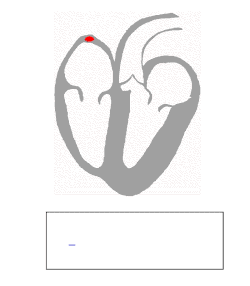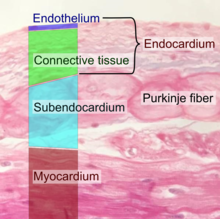Purkinje fibers
| Purkinje fibers | |
|---|---|
 Isolated heart conduction system showing Purkinje fibers | |
 The QRS complex is the large peak. | |
| Details | |
| Identifiers | |
| Latin | rami subendocardiales |
| MeSH | D011690 |
| TA98 | A12.1.06.008 |
| TA2 | 3961 |
| FMA | 9492 |
| Anatomical terminology | |
The Purkinje fibers, named for
Histology

This section needs additional citations for verification. (November 2020) |
Purkinje fibers are a unique
Given no aberrant channels, the Purkinje fibers are distinctly shielded from each other by collagen or the cardiac skeleton.
The Purkinje fibers are further specialized to rapidly conduct impulses (having numerous fast
Function
Heart rate is governed by many influences from the
Impulse carrying
During the
Replacement pacemaker
Purkinje fibers also have the ability of firing at a rate of 20–40 beats per minute if upstream conduction or pacemaking ability is compromised.[9] In contrast, the SA node in normal state can fire at 60-100 beats per minute.[9] In short, they generate action potentials, but at a slower rate than the sinoatrial node.[9] This capability is normally suppressed. Thus, they serve as the last resort when other pacemakers fail. When a Purkinje fiber does fire, it is called a premature ventricular contraction or PVC, or in other situations can be a ventricular escape.
Etymology
Purkinje fibers are named after the Czech scientist Jan Evangelista Purkyně, who discovered them in 1839.[10]
See also
References
- ISBN 978-0-521-15255-6.
- ISBN 978-0-12-382163-8, retrieved November 13, 2020
- ISBN 978-0-12-384860-4, retrieved November 13, 2020
- ^ "Purkinje fiber." The American Heritage® Medical Dictionary. 2007. Houghton Mifflin Company 23 Oct. 2016 http://medical-dictionary.thefreedictionary.com/Purkinje+fiber
- ^ S2CID 239396730, retrieved November 13, 2020
- ^ Paxton, Steve; Peckham, Michelle; Knibbs, Adele (2003). "histology of purkinje fibres".
- S2CID 117312416, retrieved November 13, 2020
- ^ Podrid, Philip J.; Kowey, Peter R. (2010). Cardiac Arrhythmia, Mechanism, Diagnosis and Management.
- ^ ISBN 978-0-12-374976-5, retrieved November 13, 2020
- ^ "Jan Evangelista Purkinje | Czech physiologist | Britannica". Britannica.com. Retrieved January 16, 2021.
External links
- Anatomy photo: Circulatory/heart/purkinje/purkinje1 - Comparative Organology at University of California, Davis – "Mammal heart, purkinje fibers (LM, Medium)"
- Anatomy Atlases – Microscopic Anatomy, plate 05.78
- MedEd at Loyola Histo/practical/cardio/hp8-21.html
- Human Cardiac Muscle, histology slides at UC San Diego
- Cardiac Muscle Tissue with Purkinje Fibers, Lonestar College North Harris Biology
